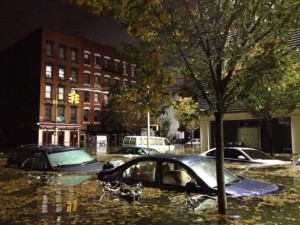
As President Obama declared a state of emergency in the wake of Sandy’s pounding of New York City, there are an increasing number of voices arguing that this really is climate change in action.
Yesterday, the former Michigan Governor Jennifer Granholm appeared on Current TV. The host of the programme Cenk Uygur noted the lack of mention of climate change in relation to Sandy up until then.
“There were 94 mentions of Hurricane Sandy in the newspapers,” said Uygur “Not one of them mentioned climate change.”
Uygur also criticised three presidential debate moderators for not raising climate change during the three debates, accusing the media of “ignoring climate change.”
“There’s a clear link to climate change,” Granhom said of Sandy. “And, yet, for the first time in over a quarter century, climate change was not brought up even once at the presidential debates.”
That lack of any mention of climate change in the three Presidential debates has been dubbed “climate silence”, which now has a dedicated website to highlight the issue. The website argues that Obama and Romney’s “failure to connect the dots and do the math imperils our nation and prevents the development of a national and global plan to respond to the most urgent challenge of our era. It’s time for their climate silence to end.”
Others have started to connect the dots too. “This will be perceived as a climate-change-related event by much of the public” writes the science writer, Chris Mooney on the Climate Desk. “Weird, extreme weather makes people worry, makes them think the world is changing. They aren’t wrong about that.”
Mooney lays out the arguments as to why he believes Sandy can be linked to climate change, including increased precipitation, increased sea level, increased sea surface temperatures, and its massive size. “Warm oceans are jet fuel for hurricanes, so it’s fair to say that these warmer temperatures are revving Sandy’s engine” he writes.
Mark Fischetti is a senior editor at Scientific American who covers energy, environment and sustainability issues. He is another person who argues that “Climate change amps up other basic factors that contribute to big storms.”
He writes that “Hurricane Sandy has emboldened more scientists to directly link climate change and storms, without the hedge. On Monday, as Sandy came ashore in New Jersey, Jonathan Foley, director of the Institute on the Environment at the University of Minnesota, tweeted: “Would this kind of storm happen without climate change? Yes. Fueled by many factors. Is [the] storm stronger because of climate change? Yes.””
Indeed, it is not as if we haven’t been warned enough by climate scientists speaking clearly through the fog of disinformation from the climate sceptics, who continue to try and sow controversy and doubt. Yesterday, I blogged how Kevin Trenberth, former head of the Climate Analysis Section at the U.S. National Center for Atmospheric Research argues that “All weather events are affected by climate change because the environment in which they occur is warmer and moister than it used to be.”
It is not as if we haven’t been warned by the insurance industry either. A few weeks ago, Munich Re, one of the world’s largest reinsurance firms, issued a study titled “Severe Weather in North America.” The insurance giant argued that: “Nowhere in the world is the rising number of natural catastrophes more evident than in North America.”
Tony Kuczinski, CEO of Munich Reinsurance America, pointed out, with uncanny foresight: “What is clearly evident when the longterm data is reviewed is that losses from weather events are trending upward. To simply say that this trend is a statistical anomaly or part of a long-term cycle of activity misses the point of these efforts – we must set aside our biases and continue a meaningful dialogue in search of answers to mitigate the losses that we are experiencing.”
And just a few weeks before that, scientists at NASA’s Goddard Institute for Space Studies published a study in the Proceedings of the National Academy of Sciences on the increase in extreme heat waves. “It follows that we can state, with a high degree of confidence, that extreme anomalies”—i.e., heat waves—“such as those in Texas and Oklahoma in 2011 and Moscow in 2010 were a consequence of global warming because their likelihood in the absence of global warming was exceedingly small.”
Chris Mooney pointedly finishes his article by arguing that “when people worry about climate change in relation to Sandy—and wonder why their presidential candidates aren’t bringing the matter up—it’s hard to say they’re misguided in doing so. In a campaign season that has studiously avoided the “C” word, Sandy reminds us that eventually, the weather always forces the issue.”
